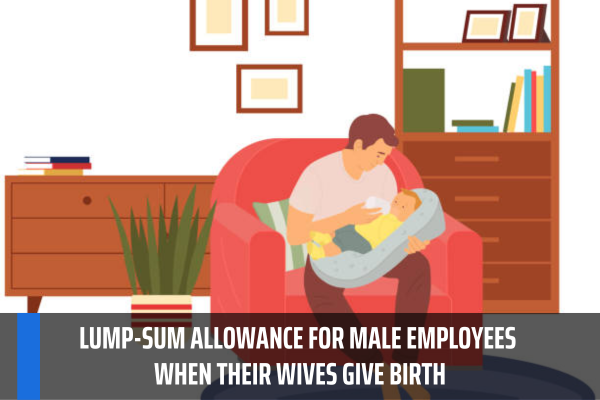Vietnam: What is the lump-sum allowance for male employees when their wives give birth in 2023?
- Vietnam: What is the lump-sum allowance for male employees when their wives give birth in 2023?
- What are the conditions for enjoying the maternity benefits in Vietnam?
- What are the regulations on paternity leave for male employees currently paying social insurance premiums whose wives give birth to children in Vietnam?
Vietnam: What is the lump-sum allowance for male employees when their wives give birth in 2023?
In Article 38 of the Law on Social Insurance 2014, there are regulations on one-time benefits when giving birth or adopting a child as follows:
Lump-sum allowance upon childbirth or child adoption
Female employees giving birth or employees adopting an under-6-month child are entitled to a lump-sum allowance equaling 2 times the statutory pay rate for each child in the month of childbirth or child adoption.
In case the mother gives birth to a child but only the father is covered by social insurance, the father is entitled to a lump-sum allowance equaling 2 times the statutory pay rate for each child in the month of childbirth.
Thus, in case the mother gives birth to a child but only the father is covered by social insurance, the father is entitled to a lump-sum allowance equaling 2 times the statutory pay rate for each child in the month of childbirth.
The current statutory pay rate is 1,800,000 VND/month.

Vietnam: What is the lump-sum allowance for male employees when their wives give birth in 2023?
What are the conditions for enjoying the maternity benefits in Vietnam?
Pursuant to Article 31 of the Law on Social Insurance 2014, it is stipulated as follows:
Conditions for enjoying the maternity benefits
1. Employees shall be covered by the maternity benefits in one of the following cases:
a/ Pregnant female employees;
b/ Female employees giving birth to children;
c/ Female employees as surrogate mothers and intended mothers;
d/ Employees adopting under-6-month children;
dd/ Female employees having intrauterine devices or employees taking sterilization measures;
e/ Male employees currently paying social insurance premiums whose wives give birth to children.
2. To enjoy the maternity benefits, employees defined at Points b, c and d, Clause 1 of this Article must have paid social insurance premiums for at least full 6 months within 12 months before childbirth or child adoption.
3. To enjoy the maternity benefits, employees defined at Point b, Clause 1 of this Article who have paid social insurance premiums for at least full 12 months and need to take a leave during pregnancy for pregnancy care as prescribed by a competent health establishment must have paid social insurance premiums for at least full 3 months within 12 months before childbirth.
4. Employees who fully satisfy the conditions specified in Clause 2 or 3 of this Article and terminate their labor contracts or working contracts or cease working before the time of childbirth or the time of adoption of under-6-month children are still entitled to the maternity benefits prescribed in Articles 34, 36 and 38, and Clause 1, Article 39, of this Law.
Thus, the current conditions for enjoying maternity benefits are implemented according to the above regulations.
What are the regulations on paternity leave for male employees currently paying social insurance premiums whose wives give birth to children in Vietnam?
Pursuant to Clause 2, Article 34 of the Law on Social Insurance 2014, it is stipulated as follows:
Leave period for childbirth
1. Female employees are entitled to a 6-month leave before and after childbirth under the maternity benefits. For a female employee who gives birth to twins or more infants, she is entitled to an additional leave of 1 month for each infant from the second.
The maternity leave period before childbirth must not exceed 2 months.
2. Male employees currently paying social insurance premiums whose wives give birth to children are entitled to a paternity leave of:
a/ 5 working days;
b/ 7 working days, in case their wives undergo a surgical birth or give birth to children before 32 weeks of pregnancy;
c/ 10 working days, in case their wives give birth to twins; or additional 3 working days for each infant from the second;
d/ 14 working days, in case their wives give birth to twins or more infants and take childbirth operation.
The paternity leave period specified in this Clause must be within the first 30 days after the date of childbirth.
3. After childbirth, if an under-2-month child dies, the mother is entitled to a 4-month leave from the date of childbirth; if a child aged 2 months or older dies, the mother is entitled to a 2-month leave from the date of the child’s death, but the maternity leave period must not exceed the period specified in Clause 1 of this Article; such leave period shall not be included in the period of personal leave as prescribed by the labor law.
4. In case only the mother is covered by social insurance or both parents are covered by social insurance but the mother dies in childbirth, the father or the direct fosterer is entitled to a maternity leave for the remaining period applicable to the mother as specified in Clause 1 of this Article. In case the mother who is covered by social insurance but does not fully satisfy the conditions specified in Clause 2 or 3, Article 31 of this Law, dies, the father or the direct fosterer is entitled to a maternity leave until the child reaches full 6 months.
5. The father or the direct fosterer who is covered by social insurance but does not take a leave under Clause 4 of this Article is entitled to not only his/her salary but also the maternity benefits for the remaining period applicable to the mother as specified in Clause 1 of this Article.
6. In case only the father is covered by social insurance and the mother dies in childbirth or faces a postnatal risk that makes her unable to care for the child, as certified by a competent health establishment, the father is entitled to a maternity leave until the child reaches full 6 months.
7. The maternity leave period specified in Clause 1, 3, 4, 5 or 6 of this Article is inclusive of public holidays, New Year holidays and weekends.
Thus, according to the above regulations, Male employees currently paying social insurance premiums whose wives give birth to children are entitled to a paternity leave of:
- 5 working days;
- 7 working days, in case their wives undergo a surgical birth or give birth to children before 32 weeks of pregnancy;
- 10 working days, in case their wives give birth to twins; or additional 3 working days for each infant from the second;
- 14 working days, in case their wives give birth to twins or more infants and take childbirth operation.
Note: The paternity leave period specified in this Clause must be within the first 30 days after the date of childbirth.
LawNet

